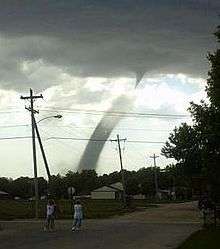Landspout

A landspout is a term coined by meteorologist Howard B. Bluestein in 1985 for a kind of tornado not associated with a mesocyclone.[1] The Glossary of Meteorology defines a landspout as
- "Colloquial expression describing tornadoes occurring with a parent cloud in its growth stage and with its vorticity originating in the boundary layer.
- The parent cloud does not contain a preexisting mid-level mesocyclone. The landspout was so named because it looks like "a weak Florida Keys waterspout over land."[2]
Landspouts are a type of tornado which forms during the growth stage of a cumulus congestus cloud by stretching boundary layer vorticity upward and into the cumulus congestus's updraft. They generally are smaller and weaker than supercell tornadoes and do not form from a mesocyclone or pre-existing rotation in the cloud. Because of this, landspouts are rarely detected by Doppler weather radar.[3]
Landspouts share a strong resemblance and development process to that of waterspouts, usually taking the form of a translucent and highly laminar helical tube. Landspouts are considered tornadoes since a rotating column of air is in contact with both the surface and a cumuliform cloud. Not all landspouts are visible, and many are first sighted as debris swirling at the surface before eventually filling in with condensation and dust.
Landspouts are often mistaken for dust devils and gustnadoes.
A few landspouts can persist in excess of 15 minutes and have produced F3 damage;[4] however, they are most commonly weak, with winds under 85 miles per hour (138 km/h) and causing little damage.[5]
See also
References
- ↑ Bluestein, Howard B. (1985). "The formation of a "landspout" in a "broken-line" squall line in Oklahoma". Preprints, 14th Conf. on Severe Local Storms, Indianapolis, American Meteorological Society. pp. 267–270. Retrieved 27 March 2007.
- ↑ American Meteorological Society (2000). "Glossary of Meteorology, Second Edition". ametsoc.org. Retrieved 27 March 2007.
- ↑ Wakimoto; Wilson (1989). "Non-supercell Tornadoes". Monthly Weather Review. 117: 1113–1140. Bibcode:1989MWRv..117.1113W. doi:10.1175/1520-0493(1989)117<1113:NST>2.0.CO;2.
- ↑ Forbes; Wakimoto (1983). "A Concentrated Outbreak of Tornadoes, Downbursts and Microbursts, and Implications Regarding Vortex Classification". Monthly Weather Review. 111: 220–235. Bibcode:1983MWRv..111..220F. doi:10.1175/1520-0493(1983)111<0220:ACOOTD>2.0.CO;2.
- ↑ National Weather Service. "EF-0 Landspout Tornado near Grand Junction, MI, on June 30, 2017". Retrieved 20 March 2018.
External links
| Wikimedia Commons has media related to landspout. |